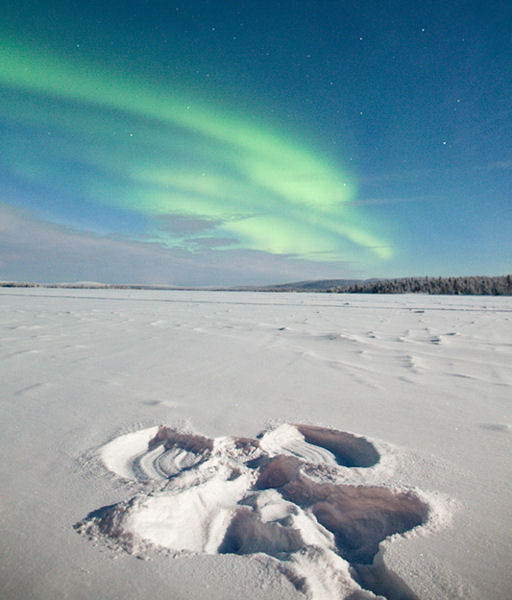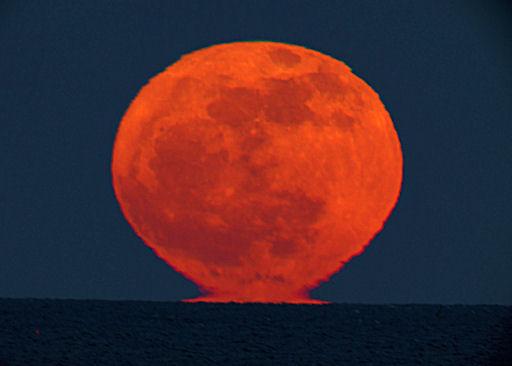Metallic photos of the sun by renowned photographer Greg Piepol bring together the best of art and science. Buy one or a whole set. They make a stellar gift. | | |
THE MOON AND MARS: Mars is approaching Earth for a close encounter in March. Start looking for the Red Planet now: Tonight it is shining brighter than a 1st-magnitude star beside the waning full Moon. The view through a backyard telescope is dynamite: sky map.
AURORA WATCH: A medium-speed solar wind stream is blowing past Earth and sparking auroras around the Arctic Circle. Last night in Muonio, Finnland, tour guide Antti Pietikäinen made a snow angel--then hopped up and took this picture:

"I took a group 20 km from Hotel Harriniva to find a clear sky," says Pietikäinen. "As soon as we reached a nearby lake, the show was on! Auroras mixed with full moonlight gives some really unique photos."
More lights are in the offing. NOAA forecasters estimate a 40% chance of polar geomagnetic activity during the next 24 hours as the solar wind continues to blow. Aurora alerts: text, voice.
MELTING SNOW MOON: According to folklore, this week's full Moon was the "Snow Moon." On Feb. 7th, John Stetson watched it melt, apparently, as it rose through a layer of relatively warm air over the waters of Cape Elizabeth, Maine:

It's a mirage, caused by sun-warmed air overlying the sea surface. The temperature profile turned Earth's atmosphere into a lens, refracting the rays of the rising Moon and distorting the lunar disk as shown. Jules Verne noticed the same kind of distortion in sunrises and sunsets, and famously likened them to an Etruscan Vase.
That's not all: "A green rim can be seen along the top of the moon," points out Stetson. "And there is a red fringe along the bottom." This is also caused by the prismatic action of the low atmosphere.
more Snow Moonshots: from Chris Allington of Little Sioux, Iowa; from Jeremy Bennetts of Leavenworth, Kansas; from Evan Ludes of Little Sioux, IA; from Robert T. Smith of Stoneville, NC; from Jack Dembicky of Sunspot, NM
January 2012 Aurora Gallery
[previous Januaries: 2010, 2009, 2008, 2007, 2005, 2004]
Comet Lovejoy Gallery
[previous comets: McNaught, Holmes, Lulin, Tuttle, Ikeya-Zhang]
Potentially Hazardous Asteroids (
PHAs) are space rocks larger than approximately 100m that can come closer to Earth than 0.05 AU. None of the known PHAs is on a collision course with our planet, although astronomers are finding
new ones all the time.
On February 9, 2012 there were 1287 potentially hazardous asteroids.
Recent & Upcoming Earth-asteroid encounters: | Asteroid | Date(UT) | Miss Distance | Mag. | Size |
| 2009 AV | Feb 16 | 44.9 LD | -- | 1.2 km |
| 2000 ET70 | Feb 19 | 17.7 LD | -- | 1.0 km |
| 2011 CP4 | Feb 23 | 9.1 LD | -- | 255 m |
| 2008 EJ85 | Mar 6 | 9.1 LD | -- | 44 m |
| 1999 RD32 | Mar 14 | 57.9 LD | -- | 2.4 km |
| 2011 YU62 | Mar 16 | 73.4 LD | -- | 1.3 km |
| 1996 SK | Apr 18 | 67.2 LD | -- | 1.6 km |
| 2007 HV4 | Apr 19 | 4.8 LD | -- | 8 m |
Notes: LD means "Lunar Distance." 1 LD = 384,401 km, the distance between Earth and the Moon. 1 LD also equals 0.00256 AU. MAG is the visual magnitude of the asteroid on the date of closest approach. | | The official U.S. government space weather bureau |
| | The first place to look for information about sundogs, pillars, rainbows and related phenomena. |
| | Researchers call it a "Hubble for the sun." SDO is the most advanced solar observatory ever. |
| | 3D views of the sun from NASA's Solar and Terrestrial Relations Observatory |
| | Realtime and archival images of the Sun from SOHO. |
| | from the NOAA Space Environment Center |
| | the underlying science of space weather |

